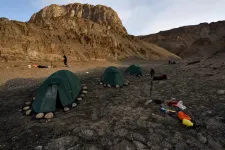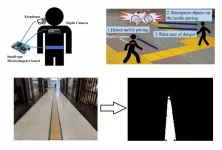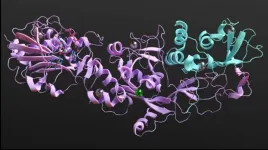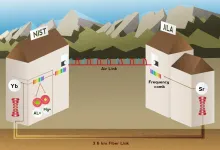Greenland caves: Time travel to a warm Arctic
An international team of scientists led by Gina Moseley from the Department of Geology at the University of Innsbruck presents the very first analysis of sediments from a cave in northeast Greenland.
2021-03-24
(Press-News.org) A 12-centimetre-thick sample of a deposit from a cave in the northeast of Greenland offers unique insights into the High Arctic's climate more than 500,000 years ago. The geologist and cave scientist Prof. Gina Moseley collected it during an exploratory expedition in 2015 for her palaeoclimatic research in one of the most sensitive areas of the world to climate change. The cave is located at 80° North 35 km from the coast and 60 km from the Greenland Ice Sheet margin. It was part of the Greenland Caves Project, funded by 59 different sponsors including the National Geographic Society. Moseley and her team are interested in the climate and environmental history captured by the unique cave deposit. "Mineral deposits formed in caves, collectively called speleothems, include stalagmites and stalactites. In this case we analysed a flowstone, which forms sheet-like deposits from a thin water film", explains Moseley. It is very special to find a deposit of this kind in the High Arctic at all, the geologist continues: "Today this region is a polar desert and the ground is frozen due to permafrost. In order for this flowstone to form, the climate during this period must have been warmer and wetter than today. The period between about 588,000 to 549,000 years before present is generally considered to be globally cool in comparison to the present. The growth of the speleothem at this time, however, shows that the Arctic was surprisingly warm".
Regional contrasts
Gina Moseley therefore highlights the regional heterogeneities that need to be considered when researching climate change especially for future developments in a warmer world. "Our results of a warmer and wetter Arctic support modelling results showing that regional heterogeneities existed and that the Arctic was anomalously warm as a consequence of the Earth's orbital relationship to the sun at the time. Associated with these warmer temperatures was a reduction of the extent of sea ice in the Arctic, thus providing open ice-free waters from which moisture could be evaporated and transported to northeast Greenland", adds the geologist from the University of Innsbruck. The speleothem palaeoclimate record offers the possibility to extend the knowledge of Greenland's past climate and hydrological conditions beyond the 128,000-year-limit of the deep Greenland ice cores. The team used state-of-the-art methods such as uranium-thorium dating which is able to enlarge the timeline much further back. "Since the Greenland ice cores are biased towards the last glacial period and therefore cold climates, the speleothem record provides a nice counter-balance with respect to past warm periods", Moseley says. "The Arctic is warming at more than twice the rate of the global average. Understanding more about how this sensitive part of the world responds in a warmer world is very important."
Valuable climate archive
Gina Moseley identified the importance of the caves in northeast Greenland back in 2008 while doing her PhD in Bristol, UK. In 2015, she led a five-person expedition funded by many different sponsors. The expedition was a challenge: The team first tried to fly as far as possible, then crossed a 20-kilometre-wide lake in a rubber boat and then had to hike for three days to get to the caves. This was the first time such climate records had been made from caves in the High Arctic and Gina Moseley was awarded the highly prestigious START Prize from the Austrian Science Fund (FWF) for her research, which enabled her to start a new six-year research project. In July 2019, Moseley and her Greenland Caves Project team returned to northeast Greenland for a three-week expedition.
INFORMATION:
Publication:
G. E. Moseley, R. L. Edwards, N. S. Lord, C. Spötl, H. Cheng: Speleothem record of mild and wet mid-Pleistocene climate in northeast Greenland. Sci.Adv. 2021, 7: eabe1260 DOI: 10.1126/sciadv.abe1260
Link: https://www.doi.org/10.1126/sciadv.abe1260
Greenland Caves Project: http://www.greenlandcavesproject.org
Innsbruck Quaternary Research Group: https://quaternary.uibk.ac.at/
[Attachments] See images for this press release:

ELSE PRESS RELEASES FROM THIS DATE:
2021-03-24
A study of 49 patients reveals that toxins from the bacterial pathogen Staphylococcus aureus can destroy the body's blood-clotting platelets, raising the risk of death during bacterial blood infections. Further experiments in mice also showed that the approved drugs ticagrelor and oseltamivir protected platelets and helped treat infections, suggesting these compounds could be repurposed into badly needed therapies for blood infections. Bacterial blood infections have mortality rates as high as 20% to 30% even with supportive care, and these rates have remained high for decades. Blood infections can also cause complications such as sepsis and endocarditis, and the rise of multidrug resistance has only compounded what was already a serious ...
2021-03-24
Immunotherapy, which recruits the body's own immune system to attack cancer, has given many cancer patients a new avenue to treat the disease.
But many cancer immunotherapy treatments can be expensive, have devastating side effects, and only work in a fraction of patients.
Researchers at the Pritzker School of Molecular Engineering at the University of Chicago have developed a new therapeutic vaccine that uses a patient's own tumor cells to train their immune system to find and kill cancer.
The vaccine, which is injected into the skin just like a traditional vaccine, stopped melanoma tumor growth in mouse models. It even worked long-term, destroying new tumors long after the therapy was given.
The results were published ...
2021-03-24
Eating just one cup of leafy green vegetables every day could boost muscle function, according to new Edith Cowan University (ECU) research.
The study, published today in the Journal of Nutrition, found that people who consumed a nitrate-rich diet, predominantly from vegetables, had significantly better muscle function of their lower limb.
Poor muscle function is linked to greater risk of falls and fractures and is considered a key indicator of general health and wellbeing.
Researchers examined data from 3,759 Australians taking part in Melbourne's Baker Heart and Diabetes Institute AusDiab study over a 12-year ...
2021-03-24
Sight is by far the sense that we humans use the most when navigating an environment. When those who are blind or visually impaired walk alone, they put themselves at great risk of falling or colliding with obstacles, especially when traversing new places. Unfortunately, the number of visually impaired people throughout the world is likely to increase in the near future because of the rapidly aging population. Thus, there is an urgent need for innovative and cost-effective solutions to help visually impaired people navigate safely.
A promising strategy that was first implemented in Japan and then replicated throughout the world is called tactile paving. Inspired by Braille, the reading system of the blind, tactile paving essentially consists of ...
2021-03-24
When invaded by a virus, our body cells launch an alert to neighboring cells to increase their antiviral defenses to prevent the infection from spreading. Some viruses, however, manage to bypass this system by mimicking the host's RNA, preventing them from being detected by the infected cell and avoiding this alert. In the case of SARS-CoV-2, this mimicking uses a protein known as nsp14. This protein is also very important for virus multiplication, a task which is facilitated by its binding to the nsp10 protein, resulting in a protein complex. Interfering with nsp14 binding and with the nsp10-nsp14 protein complex is the aim of the most recent ITQB NOVA research in COVID-19, led by researchers Margarida Saramago, Rute Matos and Cecília Arraiano.
The researchers ...
2021-03-24
Researchers find that the earliest bacteria had the tools to perform a crucial step in photosynthesis, changing how we think life evolved on Earth.
The finding also challenges expectations for how life might have evolved on other planets. The evolution of photosynthesis that produces oxygen is thought to be the key factor in the eventual emergence of complex life. This was thought to take several billion years to evolve, but if in fact the earliest life could do it, then other planets may have evolved complex life much earlier than previously thought.
The ...
2021-03-24
Beams of accelerated electrons power electron microscopes, X-ray lasers, medical accelerators and other devices. To optimize the performance of these applications, operators must be able to analyze the quality of the beams and adjust them as needed.
For the past few years, researchers at the Department of Energy's SLAC National Accelerator Laboratory have been developing "virtual diagnostics" that use machine learning to obtain crucial information about beam quality in an efficient, non-invasive way. Now, a new virtual diagnostic approach, published in Scientific Reports, incorporates additional information about the beam that allows the method to work in situations where conventional ...
2021-03-24
Despite aquaculture's potential to feed a growing world population while relieving pressure on badly depleted oceans, the industry has been plagued by questions about its environmental impacts. (Watch related video: https://www.youtube.com/watch?v=DG_nl7-naYo)
But over the years, the diverse industry - which ranges from massive open-ocean salmon cages to family farm freshwater tilapia ponds - has made significant strides toward sustainability, according to a new Stanford-led analysis.
The study notes, however, that in order for the global aquaculture sector to deliver on its full promise, more effective oversight measures are ...
2021-03-24
In a significant advance toward the future redefinition of the international unit of time, the second, a research team led by the National Institute of Standards and Technology (NIST) has compared three of the world's leading atomic clocks with record accuracy over both air and optical fiber links.
Described in the March 25 issue of Nature, the NIST-led work is the first to compare three clocks, based on different atoms, and the first to link the most advanced atomic clocks in different locations over the air. These atomic clock comparisons place the scientific community one step closer to meeting the guidelines for redefinition of the second.
"These comparisons are really defining ...
2021-03-24
Carbon dioxide in the atmosphere fuels plant growth. As carbon levels rise, it's appealing to think of supercharged plant growth and massive tree-planting campaigns drawing down the CO2 produced by fossil fuel burning, agriculture and other human activities.
New research published March 24 in Nature, however, suggests that when elevated carbon dioxide levels drive increased plant growth, it takes a surprisingly steep toll on another big carbon sink: the soil.
One likely explanation, the authors say, is that plants effectively mine the soil for nutrients they need to keep up with carbon-fueled growth. Extracting the extra nutrients requires revving up microbial activity, which then releases CO2 into the atmosphere that might otherwise remain locked in soil.
The findings contradict ...
LAST 30 PRESS RELEASES:
[Press-News.org] Greenland caves: Time travel to a warm Arctic
An international team of scientists led by Gina Moseley from the Department of Geology at the University of Innsbruck presents the very first analysis of sediments from a cave in northeast Greenland.






